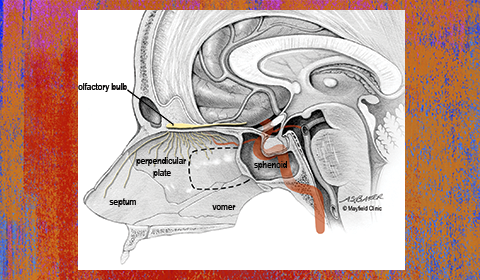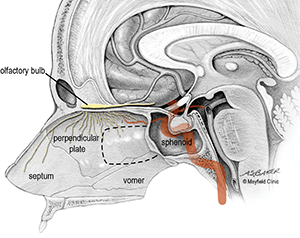
Quality of Life (QOL) Research after Endoscopic Pituitary Surgery Shows Marked Improvement at Three Months
Perceived advantages to standard sublabial approach disproved

Sagittal view of the nasal septum. Dashed line shows portion of septum removed during endoscopic pituitary surgery and preservation of olfactory fibers along the superior septum. Image provided with permission from Mayfield Clinic.
Clinicians and researchers at the University of Cincinnati Medical Center, led by Lee Zimmer, MD, PhD, Director of Rhinology and Anterior Skull Base Surgery in the Department of Otolaryngology, Head and Neck Surgery, initiated a recent study on sinonasal QOL after transnasal endoscopic approach to the sella with limited resection of nasal cavity and sinus tissues. Improvement was measured by patient-reported scores on the SNOT-22 (Sinonasal Outcome Test-22), and showed that SNOT scores were similar between preoperative and one-month testing but were significantly improved at three months.1 Until 1997, the microscopic sublabial approach was exclusively used for this surgery; as a newer procedure, little data exists regarding short-term quality of life, especially in the areas of sinonasal function.1 The study showed that although many of these changes did occur, especially compromised olfaction and increased sinus congestion, the symptoms often resolved after three months.1 These findings can help surgeons appropriately set patient expectations for the time period following transnasal endoscopic pituitary surgery.1
Fully half of pituitary surgeries are now performed using the endoscopic approach as opposed to the historical standard microscopic sublabial approach, although there continues to be some resistance to the learning curve of a “newer” procedure. However, many clinicians believe the advantages of the endoscopic approach extend beyond patient sinonasal QOL post-surgery. Zimmer cites enhanced visibility of areas such as the cavernous sinus and shorter patient hospital stays as examples.
Zimmer also points to the importance of research and education moving forward. Faculty at the University of Cincinnati College of Medicine hold two cadaveric courses annually to train both local and regional residents on the endoscopic approach to pituitary surgery. In addition, as the patient database grows, more information is available regarding not just short-term QOL measures as reported in the above-referenced study, but also long-term outcomes regarding efficacy of the procedure itself.
In addition to this new data showing improved patient sinonasal QOL scores with the endoscopic approach to pituitary surgery, Zimmer mentions other benefits that help clinicians deliver optimal patient care. “We partner with not only neurosurgery but also endocrinology, ophthalmology, and radiation oncology which is very important. Members from all specialties are involved in the decision making and care process. It’s a very streamlined process for patients with this tumor type.”
Reference:
1. Zimmer LA, Shah O, Theodosopoulos PV. Short-Term Quality-of-Life Changes after
Endoscopic Pituitary Surgery Rated with SNOT-22. J Neurol Surg B. DOI.
 Lee A. Zimmer, MD, PhD
Lee A. Zimmer, MD, PhD
Associate Professor
Director of Rhinology and Anterior Skull Base Surgery
Department of Otolaryngology, Head and Neck Surgery
University of Cincinnati Medical Center
Medical School: University of Maryland School of Medicine
513-558-4199
zimmerli@ucmail.uc.edu

